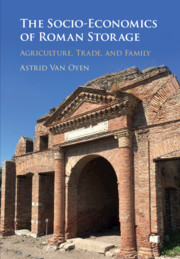Crossref Citations
This Book has been
cited by the following publications. This list is generated based on data provided by Crossref.
Nesbitt, Claire
2020.
New Book Chronicle.
Antiquity,
Vol. 94,
Issue. 378,
p.
1680.
Trainor, Conor P.
2021.
THE LATE HELLENISTIC WINE PRESS EXCAVATIONS FROM KNOSSOS: THE EARLY IRON AGE, HELLENISTIC AND EARLY ROMAN CONTEXTS.
The Annual of the British School at Athens,
Vol. 116,
Issue. ,
p.
235.
2021.
Books Received 71.1.
The Classical Review,
Vol. 71,
Issue. 1,
p.
251.
2022.
Staple Security.
p.
239.
Versluys, Miguel John
and
Sluiter, Ineke
2022.
The Palgrave Encyclopedia of the Possible.
p.
112.
2022.
Staple Security.
p.
1.
Versluys, Miguel John
and
Sluiter, Ineke
2022.
The Palgrave Encyclopedia of the Possible.
p.
1.
2022.
Staple Security.
p.
225.
Manning, Sturt W.
and
Biehl, Peter F.
2022.
Second Intermediate Period date for the Thera (Santorini) eruption and historical implications.
PLOS ONE,
Vol. 17,
Issue. 9,
p.
e0274835.
2022.
Staple Security.
p.
153.
Dodd, Emlyn
2022.
The Archaeology of Wine Production in Roman and Pre-Roman Italy.
American Journal of Archaeology,
Vol. 126,
Issue. 3,
p.
443.
2022.
Staple Security.
p.
191.
Cheung, Caroline
Chang, Stanley
and
Tibbott, Gina
2022.
Calculating dolium capacities and material use.
Archaeometry,
Vol. 64,
Issue. 3,
p.
798.
2022.
Staple Security.
p.
39.
2022.
Staple Security.
p.
113.
2022.
Staple Security.
p.
271.
2022.
Staple Security.
p.
81.
Van Limbergen, Dimitri
and
Komar, Paulina
2024.
Making wine in earthenware vessels: a comparative approach to Roman vinification.
Antiquity,
Vol. 98,
Issue. 397,
p.
85.
Eberle, Lisa Pilar
2024.
Models, Methods, and Morality.
p.
87.
Van Oyen, Astrid
2024.
Models, Methods, and Morality.
p.
381.



